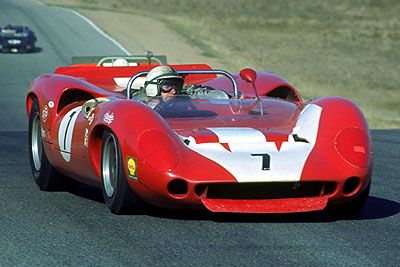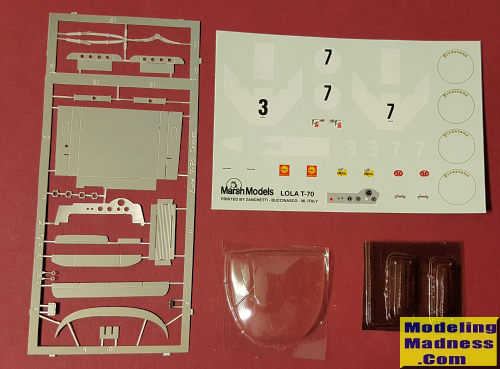
Marsh Models 1/43 Lola T-70 (Team Surtees)
|
KIT # |
MM24 |
|
PRICE: |
$49.99 back in 1996 |
|
DECALS: |
Two cars |
|
REVIEWER: |
|
|
NOTES: |
Multimedia kit. 1996 release |

|
HISTORY |
Normal power-plant was a small block V-8 of some sort generally in the 275-350 cubic inch range. Many were powered by Chevrolet engines, but you could also find Fords and Buick/Olds/Pontiac (BOP) engines as well. The car was initially raced in 1965 and was the most widely used sports racer of its type through 1967. Literally dozens of teams fielded the T-70 and it saw a great deal of success during that time, winning the initial Can Am in 1966 driven by John Surtees.
It was the Lola T-70 that
John Surtees drove to victory in the first Can-Am series of races in 1966.
He won three of the six races and with it the championship. During the
series he teamed with Graham Hill in several events. Surtees, an
ex-motorcycle champion, always drove hard which meant he either won or
finished down in the order.
|
THE KIT |
 For those of you who have had no experience with short run
1/43 car kits, this one is pretty typical of the genre. Not that long ago,
there would have been no resin in it and the body would have also been done
in metal. When I went through a stint of building these kinds of kits about
35 years back, that is how they were done. However, the level of detail
available in resin has changed things quite a bit. As you can see, the 'frame'
and many other bits such as the roll bar, wheel inserts, seat and such are
in pewter. This kit has a fret of etched metal that is generic for the Lola
T-70s that Marsh produces. The little injector stack inlets are pieces of metal
and you get bronze axles. There are also vacuform intake screens
For those of you who have had no experience with short run
1/43 car kits, this one is pretty typical of the genre. Not that long ago,
there would have been no resin in it and the body would have also been done
in metal. When I went through a stint of building these kinds of kits about
35 years back, that is how they were done. However, the level of detail
available in resin has changed things quite a bit. As you can see, the 'frame'
and many other bits such as the roll bar, wheel inserts, seat and such are
in pewter. This kit has a fret of etched metal that is generic for the Lola
T-70s that Marsh produces. The little injector stack inlets are pieces of metal
and you get bronze axles. There are also vacuform intake screens
 The body is held to the frame with two screws. Care must be
used when applying these and the smart builder will want to predrill the
holes prior to using them to prevent problems with the resin splitting. The
detail level of the metal bits is quite good as is the resin body. The
edges on the resin parts will need some clean up as will the
various openings of the body. No air bubbles were noted, which is a big
plus. The vacuformed windscreen fits into the opening quite well during a
test fit.
The body is held to the frame with two screws. Care must be
used when applying these and the smart builder will want to predrill the
holes prior to using them to prevent problems with the resin splitting. The
detail level of the metal bits is quite good as is the resin body. The
edges on the resin parts will need some clean up as will the
various openings of the body. No air bubbles were noted, which is a big
plus. The vacuformed windscreen fits into the opening quite well during a
test fit.
Instructions are a little on the basic side for those of us used to building aircraft kits. It consists of an exploded view of all the parts with color information supplied where it is needed. Frankly, it is more than adequate for the build as there are not a lot of parts involved. The other side of the single sheet instructions contain a markings and mirror placement guide for the two options provided. The #7 car was driven by Surtees and the #3 car was for Graham Hill. Decals look to be quite good and are printed in Italy. (Marsh is a British company).
|
CONCLUSIONS |
The kit looks just super in the box and while some of the very small parts may be rather fiddly, with a bit of work, it can be made into a superb model. One thing for sure is that these kits have become quite expensive, especially the out of production ones like this. It has one searching for less expensive alternatives. Though it won't be a large model, it will be a beauty.
April 2018
Copyright ModelingMadness.com. All rights reserved.
If you would like your product reviewed fairly and fairly, please contact the editor or see other details in the Note to Contributors.